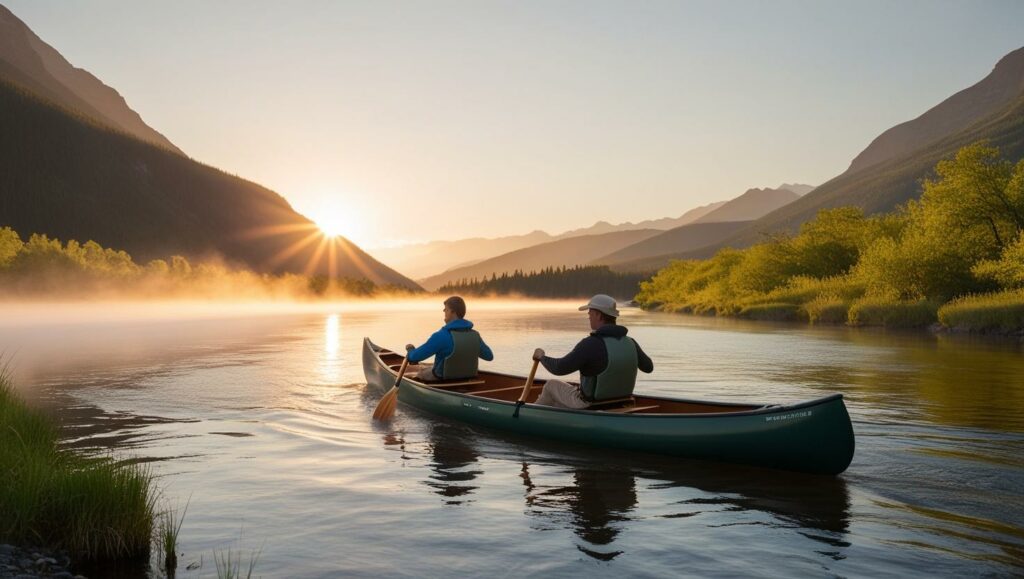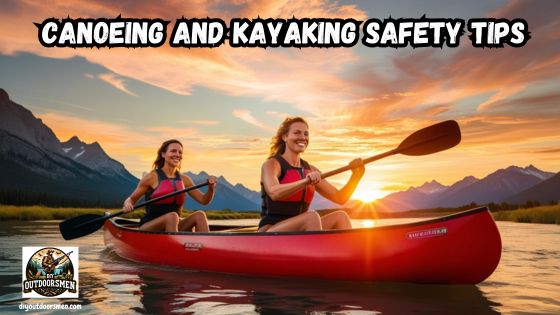Contents
- 1 Essential Safety Equipment and the Role of Personal Flotation Devices
- 2 Understanding Your Environment and Assessing Water Conditions
- 3 Basic Paddling Techniques and Staying Balanced
- 4 Pre-Trip Preparation and Critical Safety Gear
- 5 Learning Self-Rescue and Seeking Training Opportunities
- 6 Common Challenges and Considerations When Paddling
- 7 Advanced Water Safety Practices and Techniques
- 8 Frequently Asked Questions
- 8.0.1 Question: Is it safe to paddle in cold water if I wear a PFD?
- 8.0.2 How do I know if the water conditions are safe?
- 8.0.3 What should I do if I capsize?
- 8.0.4 Can beginners safely paddle on rivers?
- 8.0.5 Why is pre-trip equipment inspection important?
- 8.0.6 What should I do if I get caught in a strong rip current?
- 9 Final Thoughts on Water Safety for Canoeing and Kayaking
I have always had a strong interest in water-based activities. Canoeing and kayaking are two ways I enjoy the outdoors, especially when proper water safety tips are followed. In this article, I share my insights on essential water safety tips for canoeing and kayaking based on my experience and research.
QUICK LOOK:
Always Wear a PFD: Water safety starts with the right gear. In my experience, one cannot overemphasize the role of a personal flotation device (PFD) for anyone on the water. Even if you are a strong swimmer, a PFD provides very important buoyancy in emergency situations.
Inspect Your Equipment for Damage: This includes checking canoes or kayaks for any damage, ensuring paddles are secure, and verifying that straps or lanyards related to PFDs are in good condition. I also keep a basic first aid kit on board as an extra precaution.
Understand the Environment and Water Conditions: I have learned that water conditions often change quickly, so being aware of current and forecasted weather is very important. Understanding river currents, tides, and even local wildlife habits can influence the level of risk. Before each outing, I review local weather reports and water condition updates.
Know Your Skill Level and Proper Paddling Techiques: Proper technique not only improves your paddling efficiency but also gives a boost to your safety. I have practiced a range of strokes to maintain balance and control my kayak or canoe effectively.
Proper Trip Planning: This planning covers not just equipment checks but also knowing basic self-rescue techniques and carrying necessary safety items. Items such as a whistle, communication devices like a waterproof radio or cell phone, spare paddles, and a tow line can be important additions to your water safety kit.
Learn Rescue Techniques: A strong part of water safety is being able to handle an emergency on your own. I learned that knowing how to execute a self-rescue can make a big difference if you ever capsize.
I cover equipment, techniques, and ways to respond to unexpected situations, making sure you have the information to enjoy your paddling experience safely. Over the years, I have refined my approach by studying local water patterns and continually practicing proper gear maintenance, which gives a boost to my overall confidence when I’m out on the water.
Essential Safety Equipment and the Role of Personal Flotation Devices
Water safety starts with the right gear. In my experience, one cannot overemphasize the role of a personal flotation device (PFD) for anyone on the water. Even if you are a strong swimmer, a PFD provides very important buoyancy in emergency situations.
I always choose a well-fitting, approved life jacket, and I encourage others to do the same. Knowing that you have added protection can give a boost to confidence while paddling. Before setting out, I inspect both my paddling craft and my safety gear.
This includes checking canoes or kayaks for any damage, ensuring paddles are secure, and verifying that straps or lanyards related to PFDs are in good condition. I also keep a basic first aid kit on board as an extra precaution.
In addition to these checks, I stress the importance of regular maintenance and cautious storage. After each trip, I clean my gear thoroughly and perform any necessary repairs. Using high-quality materials and replacing worn-out equipment is a strategy I rely on to ensure every journey is as safe as possible.
Understanding Your Environment and Assessing Water Conditions
One of the key aspects of water safety is knowing your surroundings. I have learned that water conditions often change quickly, so being aware of current and forecasted weather is very important. Understanding river currents, tides, and even local wildlife habits can influence the level of risk. Before each outing, I review local weather reports and water condition updates.
Paddling in unfamiliar waters means taking extra time to assess potential hazards. I look at water depth, potential obstacles such as rocks or logs, and possible changes in water flow. I also check for clear information on any local hazards communicated by park services or community boards. This kind of preparation helps me avoid situations that may be more difficult than expected.
Moreover, I routinely study tide charts and river maps to get a feel for the water’s behavior throughout the day, as well as any areas of rapids that may need to be navigated. This practice allows me to plan a paddle route that minimizes sudden risks, ensuring that my adventure remains both fun and safe.
Basic Paddling Techniques and Staying Balanced
Proper technique not only improves your paddling efficiency but also gives a boost to your safety. I have practiced a range of strokes to maintain balance and control my kayak or canoe effectively.
Keeping a low center of gravity is very important. I remind myself to avoid sudden weight shifts, which can destabilize the boat. When using a canoe, ensuring that the vessel stays at a right angle to incoming waves minimizes the risk of capsizing.
Equally important is learning to steer the watercraft using gentle and consistent movements. In my practice sessions, I have focused on smooth strokes rather than vigorous ones that might throw me off balance. Understanding your vessel’s design and behavior during turns and maneuvers lets me predict how it will react in various water conditions.
This fundamental technique is built on training and practice. I spent many hours on calm waters before tackling more challenging conditions. Incorporating breathing exercises and rhythmic paddling has also helped me maintain focus and coordination even when faced with unexpected currents or wind gusts.
Pre-Trip Preparation and Critical Safety Gear
I consider pre-trip planning to be a major part of ensuring water safety. This planning covers not just equipment checks but also knowing basic self-rescue techniques and carrying necessary safety items. Items such as a whistle, communication devices like a waterproof radio or cell phone, spare paddles, and a tow line can be important additions to your water safety kit.
When planning a paddling trip, I always take the extra time to pack waterproof clothing suitable for the conditions. I make sure I have layered clothing options, including waterproof outer layers and extra dry clothes in case of unexpected contact with cold water. Other items I carry include a bilge pump for dry canoes or kayaks, which is useful if water starts accumulating in the craft.
Additionally, I take note of the local emergency response information. This includes knowing the nearest locations for help in unplanned circumstances, such as access points to land or contact details for local authorities. I also map out my route carefully before departure, making sure that I always have a clear idea of alternate landing spots or safe zones if the situation calls for it.
Learning Self-Rescue and Seeking Training Opportunities
A strong part of water safety is being able to handle an emergency on your own. I learned that knowing how to execute a self-rescue can make a big difference if you ever capsize. Basic techniques include re-entering your kayak or canoe and signaling for help once you are safely back in the vessel.
I have practiced these drills in controlled environments and always perform them with guidance before heading into more demanding situations. Formal training has also greatly influenced my comfort level on the water. Taking a paddling safety course is a wise decision for both beginners and experienced paddlers.
Through structured courses offered by recognized organizations, I have acquired skills such as how to maneuver in rough water, the correct use of safety gear, and effectively communicating on the water. Learning from certified instructors means receiving practical advice from those who get a sense of local conditions and potential hazards in a very clear manner.
Moreover, I often participate in group training sessions where we simulate various emergency scenarios. These practice drills, combined with one-on-one coaching, have allowed me to refine my self-rescue techniques further. The hands-on experience helps build not only technical skills but also mental preparedness, which is essential when facing real-world challenges on the water.
Common Challenges and Considerations When Paddling
There are a few challenges that beginners likely face when they start canoeing or kayaking. I have noticed that some issues recur and can be addressed with cautious planning. One common challenge is dealing with unexpected weather changes. I always advise checking weather conditions shortly before leaving the shore and continuously monitoring them if possible.
- PFD Compliance: It is important never to skip wearing a PFD. Even in calm waters, the risk of capsizing remains, so I keep my life jacket on at all times.
- Understanding Water Conditions: Changes in current speed or direction can alter your control over the vessel. I remind myself to keep a safe distance from rapid areas or turbulent sections of water.
- Equipment Checks: Damage to any part of the canoe or kayak can lead to problems. I perform regular checks before every outing, ensuring that my boat remains seaworthy and that all gear functions properly.
- Unplanned Contacts with the Water: Even experienced paddlers can fall in unexpectedly. In such cases, knowing self-rescue techniques and keeping warm clothing on board is essential.
Facing these challenges head-on with careful planning has made my time on the water both enjoyable and safe. I have learned that a combination of preparedness and flexibility can significantly lower the risks. Taking time to adjust techniques based on current conditions and constantly refining one’s approach creates a safer and more rewarding paddling experience.
Further, I advise new paddlers to always share their route with someone on land and use tracking devices when available, ensuring that help is accessible if plans change unexpectedly.
Advanced Water Safety Practices and Techniques
Once I gained fundamental skills, I looked into more advanced water safety practices. These practices provide additional peace of mind by preparing for a variety of situations that might occur during a paddling adventure.
One advanced practice I follow is regularly reviewing my technique in simulated scenarios. This includes practicing re-entry drills after a capsize and perfecting my coordination to avoid sudden weight shifts.
Taking advanced courses in open water rescue brings further expertise to my daily preparations. By refreshing my basic safety skills and learning new methods in diverse conditions, I have witnessed improved handling of unexpected events.
These courses often involve both theoretical knowledge and in-field exercises, which emphasize the importance of consistent practice. Another key aspect that I value is communication. When paddling in group outings, having a pre-arranged communication signal or plan helps manage situations effectively.
Using a whistle or other sound-based signaling device quickly alerts everyone if there is a problem. I also maintain contact through waterproof devices when possible, especially if I am paddling far from shore.
Advanced safety tips involve fine-tuning the use of safety gear. Beyond a basic PFD, I consider the use of hybrid safety tools essential. Items such as a self-inflating life vest for colder water or a connector strap that links multiple boats can serve as backup in emergencies.
I encourage paddlers to be proactive in upgrading or switching things up in their safety equipment as they gain more experience. Regular drills with a trusted group and reviewing the latest in safety technology can really take your preparedness to the next stage.
Frequently Asked Questions
Many questions arise when dealing with water safety for canoeing and kayaking. I have collected some common ones and provided answers based on my experiences and advice from experts.
Question: Is it safe to paddle in cold water if I wear a PFD?
Yes, wearing a PFD in cold water is essential as it ensures buoyancy even if hypothermia becomes a risk. I also recommend wearing insulated and waterproof clothing to maintain body heat.

How do I know if the water conditions are safe?
Assessing water conditions involves checking weather reports, tide information, and local advisories. I always look for updates from reliable sources before I start my trip. In addition, I suggest staying connected with local paddling clubs that post real-time alerts.
What should I do if I capsize?
Knowing self-rescue methods is very important. I practice re-entering my kayak or canoe in safe conditions. Maintain calm and use your paddle to assist in re-entry. Additionally, signaling for help is important if you are not alone on the water.
Can beginners safely paddle on rivers?
Beginners should start on calm lakes or slower-moving rivers. I suggest practicing in controlled environments until you build up your skills before venturing into fast-flowing water.
Why is pre-trip equipment inspection important?
Routine inspections of your canoe or kayak and safety gear help reveal any wear or potential issues. In my experience, proper equipment checks can prevent small issues from turning into major concerns while on the water.
What should I do if I get caught in a strong rip current?
If you find yourself caught in a rip current, remain calm and paddle parallel to the shore until you are out of the current. Then, paddle back towards the shore at a safe angle. Always remember that preparation and practice are key to managing such situations.
Final Thoughts on Water Safety for Canoeing and Kayaking
Canoeing and kayaking provide an eye-catching way to engage with nature. Having proper water safety tips in place makes each outing more enjoyable and less risky. I take personal responsibility for ensuring that the necessary equipment is in excellent condition before I paddle out.

Wearing a PFD at all times, understanding surroundings, and knowing self-rescue techniques have made a significant difference in my overall experience. Investing time in training, whether through local clubs or formal courses, gives me the skills needed to enjoy the water safely.
I practice by starting in calm areas and gradually moving to more challenging conditions as I gain confidence. This gradual improvement process is helpful for everyone, particularly novices who are still becoming comfortable with their vessels.
Preparation on the water is not just about having the right equipment. It also means understanding your capabilities, being aware of sudden environmental changes, and constantly reviewing the techniques you’ve learned.
Each outing is an opportunity to learn something new about water behavior and personal limits. Regular self-assessments and participation in group safety sessions add a layer of readiness that is invaluable.
In the end, the proper safety measures not only protect your well-being but also allow you to relax and enjoy nature. If you always prepare carefully, check equipment, and continuously learn new techniques, you can reduce the risk of unexpected problems significantly. I encourage anyone interested in paddling to take these water safety tips seriously and apply them to every outing.
Experience on the water is cumulative, and every trip offers a learning opportunity. Familiarity with local water conditions, continuous practice of basic techniques, and staying well prepared are habits that have served me well and can serve you too.
With ongoing caution and a steady approach, every paddle can yield a memorable and safe adventure. Remember that being proactive about safety means you are setting yourself up for countless enjoyable excursions on the water, where each journey is as enriching as it is exciting.
Most Recent Articles:
- Complete Guide On Tracking Game Animals

- DIY 4-Step Guide To Field Dressing And Quartering A Deer

- Night Vision Binoculars For Nocturnal Hunting

- The Science Behind Camouflage Patterns For Deer Hunting

- Binocular Accessories For Hunters

- 9 Tips for Using Trail Cameras To Track Deer Movements

As always, stay safe, enjoy the journey, and please try to leave it cleaner than you found it. If you have any comments, questions, ideas, or suggestions, please leave them in the comment section below, and I’ll get back to you ASAP. You can follow us on YouTube: Man Art Creations for videos of our DIY Adventures.
P.S. Thanks so much for checking out our blog; we really appreciate it. Just so you know, we may receive a commission if you click on some of the links that appear on our site. This helps us keep our content free and up-to-date for everyone. We appreciate your support!



